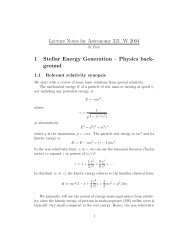Lecture Notes for Analog Electronics - The Electronic Universe ...
Lecture Notes for Analog Electronics - The Electronic Universe ...
Lecture Notes for Analog Electronics - The Electronic Universe ...
You also want an ePaper? Increase the reach of your titles
YUMPU automatically turns print PDFs into web optimized ePapers that Google loves.
Class <strong>Notes</strong> 4<br />
3.5 Frequency Domain Analysis (contd.)<br />
Be<strong>for</strong>e we look at some more examples using our technique of complex impedance, let’s look<br />
at some related general concepts.<br />
3.5.1 Reactance<br />
First, just a redefintion of what we already have learned. <strong>The</strong> term reactance is often used<br />
in place of impedance <strong>for</strong> capacitors and inductors. Reviewing our definitions of impedances<br />
from Section 3.2 we define the reactance of a capacitor ˜ XC to just be equal to its impedance:<br />
˜XC ≡−ı/(ωC). Similarly, <strong>for</strong> an inductor ˜ XL ≡ ıωL. This is the notation used in the text.<br />
However, an alternative but common useage is to define the reactances as real quantities.<br />
This is done simply by dropping the ı from the definitions above. <strong>The</strong> various reactances<br />
present in a circuit can by combined to <strong>for</strong>m a single quantity X, which is then equal to the<br />
imaginary part of the impedance. So, <strong>for</strong> example a circuit with R, L, andCin series would<br />
have total impedance<br />
˜Z = R + ıX = R + ı(XL + XC) =R+ı(ωL − 1<br />
ωC )<br />
A circuit which is “reactive” is one <strong>for</strong> which X is non-negligible compared with R.<br />
3.5.2 General Solution<br />
As stated be<strong>for</strong>e, our technique involves solving <strong>for</strong> a single Fourier frequency component<br />
such as ˜ V = Ve ı(ωt+φ) . You may wonder how our results generalize to other frequencies and<br />
to input wave<strong>for</strong>ms other than pure sine waves. <strong>The</strong> answer in words is that we Fourier<br />
decompose the input and then use these decomposition amplitudes to weight the output we<br />
found <strong>for</strong> a single frequency, Vout. We can <strong>for</strong>malize this within the context of the Fourier<br />
trans<strong>for</strong>m, whch will also allow us to see how our time-domain differential equation became<br />
trans<strong>for</strong>med to an algebraic equation in frequency domain.<br />
Consider the example of the RC low-pass filter, or integrator, circuit of Fig. 7. We<br />
obtained the differential equation given by Eq. 2. We wish to take the Fourier trans<strong>for</strong>m of<br />
this equation. Define the Fourier trans<strong>for</strong>m of V (t) as<br />
v(ω)≡F{V(t)}= 1<br />
� +∞<br />
√ dte<br />
2π −∞<br />
−ıωt V (t) (10)<br />
Recall that F{dV/dt} = ıωF{V}. <strong>The</strong>re<strong>for</strong>e our differential equation becomes<br />
Solving <strong>for</strong> v(ω) gives<br />
ıωv(ω)+v(ω)/(RC) =F{Vin(t)}/(RC) (11)<br />
v(ω)= F{Vin(t)}<br />
1+ıωRC<br />
13<br />
(12)













